
Our eclipse viewing site
Thursday, June 21, was eclipse day, the whole reason for the trip. The weather had been fantastic so far, hardly a cloud in the sky since we'd arrived in Africa. But as the morning wore on, the unthinkable happened: clouds blew in, seemingly out of nowhere. I watched them move for awhile, and they seemed to be mostly up north, perhaps following the Zambezi River, and mostly out of our way. Then, a second front blew in from the south, and we began to get truly nervous.
But after a couple of anxious hours, the clouds just vanished. By the time we got to the eclipse viewing site just after noon, the sky was clear pretty much horizon-to-horizon. And it was when we got to the site that we found why we had been booked into this camp: the site was about as ideal as you could hope for. About a 10-minute drive from the camp, it was on a hill with an excellent view for almost 360 degrees around. The camp staff had set up an open tent as a makeshift boma, and laid out lunch and drinks to enjoy as we waited for first contact, the moment when the Moon first begins to slide in front of the Sun, at about 1 p.m. They even brought chairs.

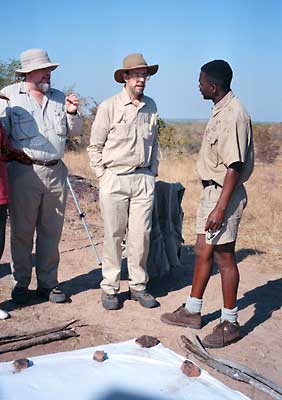 Dave & Ron double-team a guide on the physics of shadow bands Photo by Pam Bloxham |
Somebody had brought along a white sheet to lay on the ground to catch a glimpse of shadow bands, an elusive light interference phenomenon that sometimes happens just before and after totality, and this was also a good surface for projecting pinhole images on. All you need do is poke a small pinhole in a sheet of cardboard or something, or even just make a small opening between your fingers, and you fashion a makeshift pinhole camera that gives you an image of the partially-eclipsed Sun. Somebody even used a wicker hat to project dozens of little crescent Sun images on the sheet. | 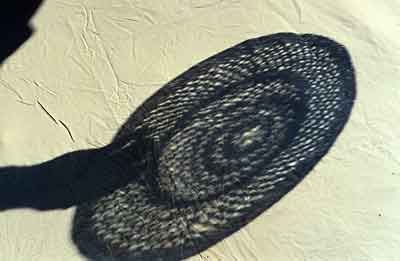 |
I'd never seen shadow bands myself, and they don't always appear. But seconds before totality, somebody called out "shadow bands!" and sure enough, there they were, very faint dark bands moving across the sheet like ripples on a pond.

| And then the Sun went out. The people who don't understand what all the fuss is about get converted in that moment. Click here for more photos of totality. | 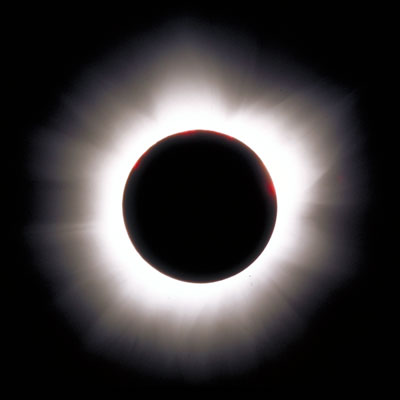 |
Some people cheered, others watched silently in awe. Myself and few others had no time for that, we were frantically trying to squeeze out the maximum number of photos of the event in the all-too-brief three minutes. I think I managed to actually stop once or twice and just look at the glowing black hole in the sky, but the whole memory is kind of a blur now.
This was a really excellent eclipse, even by the usual standards. The Sun was near "solar max," the peak of solar storm activity that runs in an 11-year cycle, so the corona was particularly large and complex, and there were several large red prominences visible.
The other thing that astonishes first-time eclipse viewers is just how fast three minutes can slip by. All too soon, we reached third contact, then end of totality, to my traditional, plaintive wail of "not YET!!!" Once again, the shadow bands made their brief appearance.
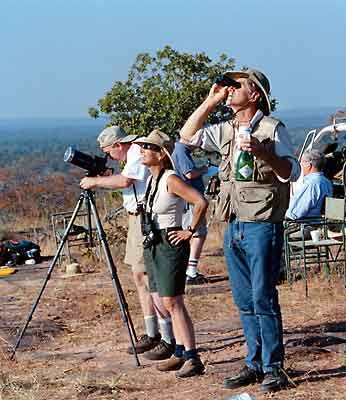 David with the bubbly, aprés totality |
Afterwards was the usual: hugging, exultation, the comparing of notes, "did you see
those prominences?" And champagne. That seems to have become part of our post-
eclipse ritual since Romania.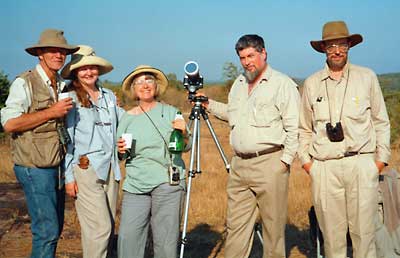 The African Expeditionary Force: David, Kathy, Pam, Dave, Ron |
| After the excitement of totality, the interval to fourth contact, when the Moon finally slips past the Sun, is an anti-climax, and only the real hard-core eclipse fanatics spend a lot of time watching it. Really, it's pretty much the same show as first-to-second contact, but played in reverse. After a half-hour or so of celebrating and taking the occasional peek at the regrowing Sun, we began to pack up and make the preparations for return to camp. | 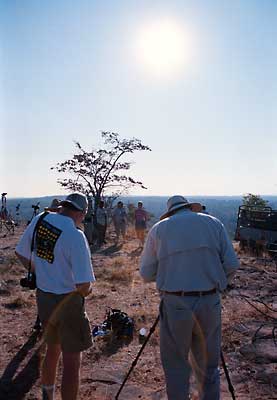 Watching the Sun come back |
And so it was back to the realities of safari camp life. We had all sent out clothes for washing the day before, and when we got back from the eclipse, our clothes were waiting for us in our room...sort of. Although we had taken care to make neat, separate bundles, al the washing from the camp had gotten somewhat jumbled along the way, so we spent much of the afternoon in clothing exchanges, trying to find the owner of this or that shirt. I still have a pair of black socks that aren't mine; I didn't notice them until after the trip.
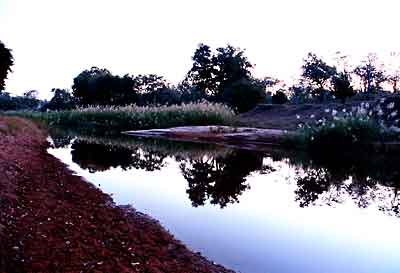 |
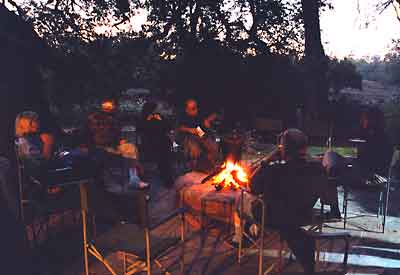 |
That night before dinner, I had a chance to perform my close-up magic act and add Zimbabwe to my performance resume. There is a standard joke in magic: "I'm an international performer. When I'm out of work, I'm out of work all over the world."
PAGE: 1 | 2 | 3 | 4 | 5 | 6 | 7 | 8 | 9 | 10 | 11 | 12 | 13 | 14 | 15